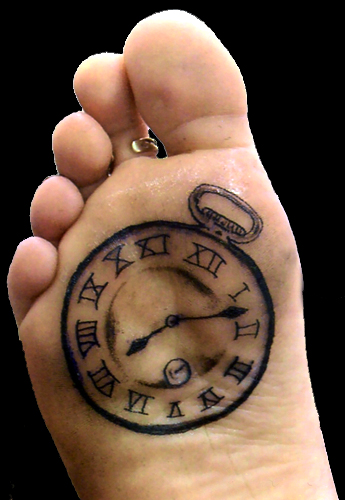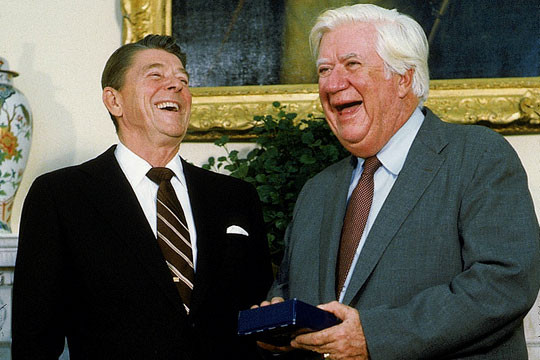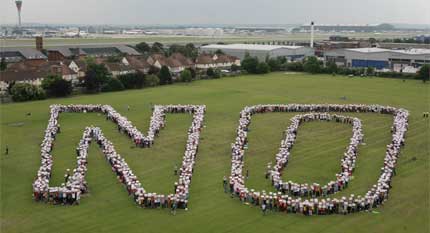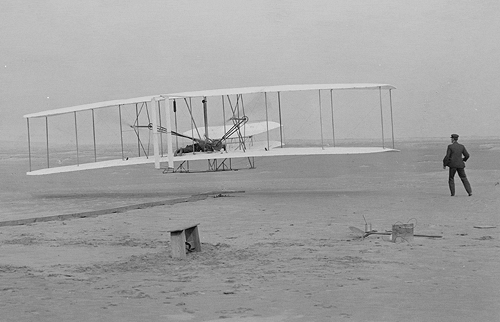Posts Tagged ‘Trust-based approach’
Choose Your Path
 There are only three things you can do:
There are only three things you can do:
1. Do what you’re told. This is fine once in a while, but not fine if you’re also told how.
2. Do what you’re not told. This is the normal state of things – good leaders let good people choose.
3. Do what you’re told not to. This is rarified air, but don’t rule it out.
Of Sound Mind and Body
 As professionals we get paid to think. But unlike professional athletes, we’ve forgotten the importance of mind and body.
As professionals we get paid to think. But unlike professional athletes, we’ve forgotten the importance of mind and body.
Clearly, mind is connected to body. (I’m not talking about a metaphysical connection, I’m talking about a physical physical connection.) There are electromechanical connections (nerves) that pass information between the two and hydromechanical connections (blood vessels) that pass chemistry (oxygen and glucose, among others). The coupling is clear – what happens in one influences the other, then the other retorts. This back-and-forth ringing is complex and real. From the outside, our system architecture is highly coupled, yet from the inside we forget.
Professional athletes want high performance, and they get it through hard work, good food, regimented eating schedules, and rest. From the outside it seems they’re all about body, but on the inside they’re all whole system optimization – mind and body. (Yogi Berra – baseball is 90% mental and the other half physical.) They know food and rest influence the body, but they also know it influences the mind. They remember, we forget.
As a professional thinker, I urge you to do all you can to think well. Eat well, eat regularly, and get rest. The cost of a bad decision is high, and they’re more likely when blood sugar is low and you’re tired. If you don’t do it for your career, do it for your company – remember, they’re paying you to think.
(Image credit: iStockphoto)
Win Hearts and Minds
 As an engineering leader you have the biggest profit lever in the company. You lead the engineering teams, and the engineering teams design the products. You can shape their work, you can help them raise their game, and you can help them change their thinking. But if you don’t win their hearts and minds, you have nothing.
As an engineering leader you have the biggest profit lever in the company. You lead the engineering teams, and the engineering teams design the products. You can shape their work, you can help them raise their game, and you can help them change their thinking. But if you don’t win their hearts and minds, you have nothing.
Engineers must see your intentions are good, you must say what you do and do what you say, and you must be in it for the long haul. And over time, as they trust, the profit lever grows into effectiveness. But if you don’t earn their trust, you have nothing.
But even with trust, you must be light on the tiller. Engineers don’t like change (we’re risk reducing beings), but change is a must. But go too quickly, and you’ll go too slowly. You must balance praise of success with praise of new thinking and create a standing-on-the-shoulders-of-giants mindset. But this is a challenge because they are the giants – you’re asking them to stand on their own shoulders.
How do you know they’re ready for new thinking? They’re ready when they’re willing to obsolete their best work and to change their work to make it happen. Strangely, they don’t need to believe it’s possible – they only need to believe in you.
Now the tough part: There’s a lot of new thinking out there. Which to choose?
Whatever the new thinking, it must make sense at a visceral level, and it must be simple. (But not simplistic.) Don’t worry if you don’t yet have your new thinking; it will come. As a seed, here are my top three new thinkings:
Define the problem. This one cuts across everything we do, yet most underwhelm it. To get there, ask your engineers to define their problems on one page. (Not five, one.) Ask them to use sketches, cartoons, block diagram, arrows, and simple nouns and verbs. When they explain the problem on one page, they understand the problem. When they need two, they don’t.
Test to failure. This one’s subtle but powerful. Test to define product limits, and don’t stop until it breaks. No failure, no learning. To get there, resurrect the venerable test-break-fix cycle and do it until you run out of time (product launch.) Break the old product, test-break-fix the new product until it’s better.
Simplify the product. This is where the money is. Product complexity drives organizational complexity – simplify the product and simply everything. To get there, set a goal for 50% part count reduction, train on Design for Assembly (DFA), and ask engineering for part count data at every design review.
I challenge you to challenge yourself: I challenge you to define new thinking; I challenge you to help them with it; I challenge you to win their hearts and minds.
Can’t Say NO
- Yes is easy, no is hard.
- Sometimes slower is faster.
- Yes, and here’s what it will take:
- The best choose what they’ll not do.
- Judge people on what they say no to.
- Work and resources are a matched pair.
- Define the work you’ll do and do just that.
- Adding scope is easy, but taking it out is hard.
- Map yes to a project plan based on work content.
- Challenge yourself to challenge your thinking on no.
- Saying yes to something means saying no to something else.
- The best have chosen wrong before, that’s why they’re the best.
- It’s better to take one bite and swallow than take three and choke.
Trust is better than control.
 Although it’s more important than ever, trust is in short supply. With everyone doing three jobs, there’s really no time for anything but a trust-based approach. Yet we’re blocked by the fear that trust means loss of control. But that’s backward.
Although it’s more important than ever, trust is in short supply. With everyone doing three jobs, there’s really no time for anything but a trust-based approach. Yet we’re blocked by the fear that trust means loss of control. But that’s backward.
Trust is a funny thing. If you have it, you don’t need it. If you don’t have it, you need it. If you have it, it’s clear what to do – just behave like you should be trusted. If you don’t have it, it’s less clear what to do. But you should do the same thing – behave like you should be trusted. Either way, whether you have it or not, behave like you should be trusted.
Trust is only given after you’ve behaved like you should be trusted. It’s paid in arrears. And people that should be trusted make choices. Whether it’s an approach, a methodology, a technology, or a design, they choose. People that should be trusted make decisions with incomplete data and have a bias for action. They figure out the right thing to do, then do it. Then they present results – in arrears.
I can’t choose – I don’t have permission. To that I say you’ve chosen not to choose. Of course you don’t have permission. Like trust, it’s paid in arrears. You don’t get permission until you demonstrate you don’t need it. If you had permission, the work would not be worth your time. You should do the work you should have permission to do. No permission is the same as no trust. Restating, I can’t choose – I don’t have trust. To that I say you’ve chosen not to choose.
There’s a misperception that minimizing trust minimizes risk. With our control mechanisms we try to design out reliance on trust – standardized templates, standardized process, consensus-based decision making. But it always comes down to trust. In the end, the subject matter experts decide. They decide how to fill out the templates, decided how to follow the process, and decide how consensus decisions are made. The subject matter experts choose the technical approach, the topology, the materials and geometries, and the design details. Maybe not the what, but they certainly choose the how.
Instead of trying to control, it’s more effective to trust up front – to acknowledge and behave like trust is always part of the equation. With trust there is less bureaucracy, less overhead, more productivity, better work, and even magic. With trust there is a personal connection to the work. With trust there is engagement. And with trust there is more control.
But it’s not really control. When subject matter experts are trusted, they seek input from project leaders. They know their input has value so they ask for context and make decisions that fit. Instead of a herd of cats, they’re a swarm of bees. Paradoxically, with a trust-based approach you amplify the good parts of control without the control parts. It’s better than control. It’s where ideas, thoughts and feelings are shared openly and respectfully; it’s where there’s learning through disagreement; it’s where the best business decisions are made; it’s where trust is the foundation. It’s a trust-based approach.
How To Fix Product Development
 The new product development process creates more value than any other process. And because of this it’s a logical target for improvement. But it’s also the most complicated business process. No other process cuts across an organization like new product development. Improvement is difficult.
The new product development process creates more value than any other process. And because of this it’s a logical target for improvement. But it’s also the most complicated business process. No other process cuts across an organization like new product development. Improvement is difficult.
The CEO throws out the challenge – “Fix new product development.” Great idea, but not actionable. Can’t put a plan together. Don’t know the problem. Stepping back, who will lead the charge? Whose problem is it?
The goal of all projects is to solve problems. And it’s no different when fixing product development – work is informed by problems. No problem, no fix. Sure you can put together one hell of a big improvement project, but there’s no value without the right problem. There’s nothing worse than spending lots of time on the wrong problem. And it’s doubly bad with product development because while fixing the wrong problem engineers are not working on the new products. Yikes.
Problems are informed by outcomes. Make a short list of desired outcomes and show the CEO. Your list won’t be right, but it will facilitate a meaningful discussion. Listen to the input, go back and refine the list, and meet again with the CEO. There will be immense pressure to start the improvement work, but resist. Any improvement work done now will be wrong and will create momentum in the wrong direction. Don’t move until outcomes are defined.
With outcomes in hand, get the band back together. You know who they are. You’ve worked with them over the years. They’re influential and seasoned. You trust them and so does the organization. In an off-site location show them the outcomes and ask them for the problems. (To get their best thinking spend money on great food and a relaxing environment.) If they’re the right folks, they’ll say they don’t know. Then, they’ll craft the work to figure it out – to collect and analyze the data. (The first part of problem definition is problem definition.) There will be immense pressure to start the improvement work, but resist. Any work done now will be wrong. Don’t move until problems are defined.
With outcomes and problems in hand, meet with the CEO. Listen. If outcomes change, get the band back together and repeat the previous paragraph. Then set up another meeting with the CEO. Review outcomes and problems. Listen. If there’s agreement, it’s time to put a plan together. If there’s disagreement, stop. Don’t move until there’s agreement. This is where it gets sticky. It’s a battle to balance everyone’s thoughts and feelings, but that’s your challenge. No words of wisdom on than – don’t move until outcomes and problems are defined.
There’s a lot of emotion around the product development process. We argue about the right way to fix it – the right tools, training, and philosophies. But there’s no place for argument. Analyze your process and define outcomes and problems. The result will be a well informed improvement plan and alignment across the company.
The Power of Now
 I think we underestimate the power of now, and I think we waste too much emotional energy on the past and future.
I think we underestimate the power of now, and I think we waste too much emotional energy on the past and future.
We use the past to create self-inflicted paralysis, to rationalize inaction. We dissect our failures to avoid future missteps, and push progress into the future. We make no progress in the now. This is wrong on so many levels.
In all written history there has never been a mistake-free endeavor. Never. Failure is part of it. Always. And learning from past failures is limited because the situation is different now: the players are different, the technology is different, the market is different, and the problems are different. We will make new mistakes, unpredictable mistakes. Grounding ourselves in the past can only prepare us for the previous war, not the next one.
Like with the past, we use the future’s uncertainty to rationalize inaction, and push action into the future. The future has not happened yet so by definition it’s uncertain. Get used to it. Embrace it. I’m all for planning, but I’m a bigger fan of doing, even at the expense of being wrong. Our first course heading is wrong, but that doesn’t mean the ship doesn’t sail. The ship sales and we routinely checks the heading, regularly consults the maps, and constantly monitors the weather. Living in the now, it’s always the opportunity for a course change, a decision, or an action.
The past is built on old thinking, and it’s unchangeable – let it go. Spend more emotional energy on the now. The future is unpredictable an uncontrollable, and it’s a result of decisions made in the now – let it go. Spend more energy on the now.
It’s tough to appreciate the power of now, and maybe tougher to describe, but I’ll take a crack at it. When we appreciate the power of now we have a bias for action; we let go of the past; we speculate on the future and make decisions with less than perfect information; and we constantly evaluate our course heading.
Give it a try. Now.
Change your work.
 You are you, and work is work, but work must fit you, not the other way around. Yet we hose it up most of the time. Most of the time it’s: “improve your weaknesses” or “close your gaps”. Make no mistake, this is code for “change yourself so you fit our work.”
You are you, and work is work, but work must fit you, not the other way around. Yet we hose it up most of the time. Most of the time it’s: “improve your weaknesses” or “close your gaps”. Make no mistake, this is code for “change yourself so you fit our work.”
I say we flip it on its head; I say change your work to fit you; I say do your work differently; do it in a way that takes advantage of your strengths; do it the way you think it should be done. It’s your work; you’re the expert; you know it best. You choose. Change your work.
With an uncertain economy and high unemployment, this change-the-work stuff sounds scary, but it’s scarier not to do it. Your company’s global competitiveness is weakened when you’re asked to change to fit the work; but when work changes to fit you, your company is more competitive. Think about it – you’re more engaged, you’re happier, you’re more productive, and you do better work.
What could be better for your company?
What could be better for you?
The Abundance Mindset
 We’re too busy. All of us. Too busy. And we better get used to it: too busy is the rule. But how to make too busy feel good? How to make yourself feel good? How to make the work better?
We’re too busy. All of us. Too busy. And we better get used to it: too busy is the rule. But how to make too busy feel good? How to make yourself feel good? How to make the work better?
Pretend there is abundance; plenty for all; assume an abundance mindset.
There’s a subtle but powerful shift with the abundance mindset. Here’s the transition:
me to we
talk to listen
verify to trust
fear to confidence
comply to embrace
compete to collaborate
next month to next week
can’t to could, could to can
no to maybe, maybe to how
The abundance mindset is not about doing more; it’s about what we do and how we do. With the abundance mindset everyone feels better, our choices are better, and our work is better.
Lincoln said “Happiness is a choice.” I think it’s the same with abundance. We’ll always be too busy, but, if we choose, there will always be an abundance of thoughtfulness, caring, and mutual respect.
Learning through disagreement
 It’s a little-know fact that you can disagree and still be a team player. (Really, it’s true.) It’s okay to disagree, but it should be done effectively. (Disagreement is not argument.) And disagreement can be a great source for learning. I learn most deeply from smart people I disagree with.
It’s a little-know fact that you can disagree and still be a team player. (Really, it’s true.) It’s okay to disagree, but it should be done effectively. (Disagreement is not argument.) And disagreement can be a great source for learning. I learn most deeply from smart people I disagree with.
As a self-declared smart person, I hold my thinking in high regard. (To advance a cause confidence in your thinking is needed.) However, like with most things, there should be balance: confidence in your thinking tempered with healthy self-examination and respect for others’ thinking. There are a lot of smart people out there, people with different life experience, training, and education. Just the folks to learn from. (Different is not inferior or incorrect, it’s just different.)
It’s a struggle to get the balance right. Hold fast? Give a little ground? Change your thinking altogether? There’s no right answer, just the conviction that it’s best to move toward balance.
Trust and mutual respect are keys to our migration toward balance. Trust helps us start deep dialog. It feels safe to initiate when there’s confidence the disagreement comes from a thoughtful, unselfish place. Mutual respect keeps the dialog going – no low blows, just shared thoughts, experiences, and data.
With trust and mutual respect, healthy disagreement has time to blossom into fuller, deeper understanding – a credit to you and the important people in your life.


 Mike Shipulski
Mike Shipulski